We are not endorsed or sponsored in any way by any of the following companies*. The links provided are just meant to be convenient and are not regularly updated. Our favorite things are a recommendation, but in no way indicate safety. Please use any products as intended, and responsibly. Always consult your veterinarian before changing your puppy’s/dog’s diet or before changing their physical routines. It’s important to consider all potential chews, treats, and toys as potential choking hazards - choose appropriately sized items for your dog, and be sure to update the size regularly for growing puppies.
Jump to:
- (Mostly) Doggo Goodies
- Trainer Accessories
- Beat the Heat (Summer-themed gear)
- Cat-specific Gear
- First Aid
- Reptile Goodies
(Mostly) Doggo Goodies
Food Puzzles
Check out Flerken’s “reviews” of food puzzles to see some of these and more ‘in action’ - I find it can really help you decide which puzzles will delight your own pup.
-
West paws toppl - spectacular for all ages, stuff these with goodies (check out our ‘recipes’ here, Kong recipes here, and creative enrichment ideas mostly for adult dogs here), or nest a large and small to create a fun dry-kibble or dry-treat puzzle. Excellent guarantee, dishwasher safe, made in the USA - doin’ us a happy.
-
Classic Kong & puppy kong - tough, reliable, and also made in the USA. Filled with just kibble, this puzzle is easy! Add in some irregular or larger shapes (treats, veggies, etc) and it bumps the difficulty. Add in something viscous (almond butter, greek yogurt, wet dog food) with the kibble and freeze whole to create a truly long-lasting food puzzle.
-
Kong lock-it puzzle - these are a great introduction to food puzzles for your puppy, but may not be tough enough for a dog who loves to chew (always supervise!). Our puppies start with one ‘lock-it’ filled with food & treats, which they lick/chew/knock around. Once they are excited about the ‘lock-it’, then we start putting a second unit very loosely on the first, so it’s very easy for the puppy to get them apart. It may take weeks to master a fully locked puzzle, which is great! Move the game forward in difficulty as your puppy/dog improves, but make sure they win more often than they quit - you want to encourage play, not frustration. Also dishwasher-safe!
-
Busy Buddy magic mushroom dog food toy - This puzzle was a huge surprise - it is HARD!! To get the food out, even on ‘easy’ (holes open wide), the dog needs to flip the puzzle upside down and back right side up, but the mushroom shape really makes it a challenge. Probably too hard for puppies under 3 mon, and extremely loud when dogs bat it around (don’t schedule a zoom meeting and offer this to your pup!), this puzzle is fun & challenging for advanced puzzle pups.
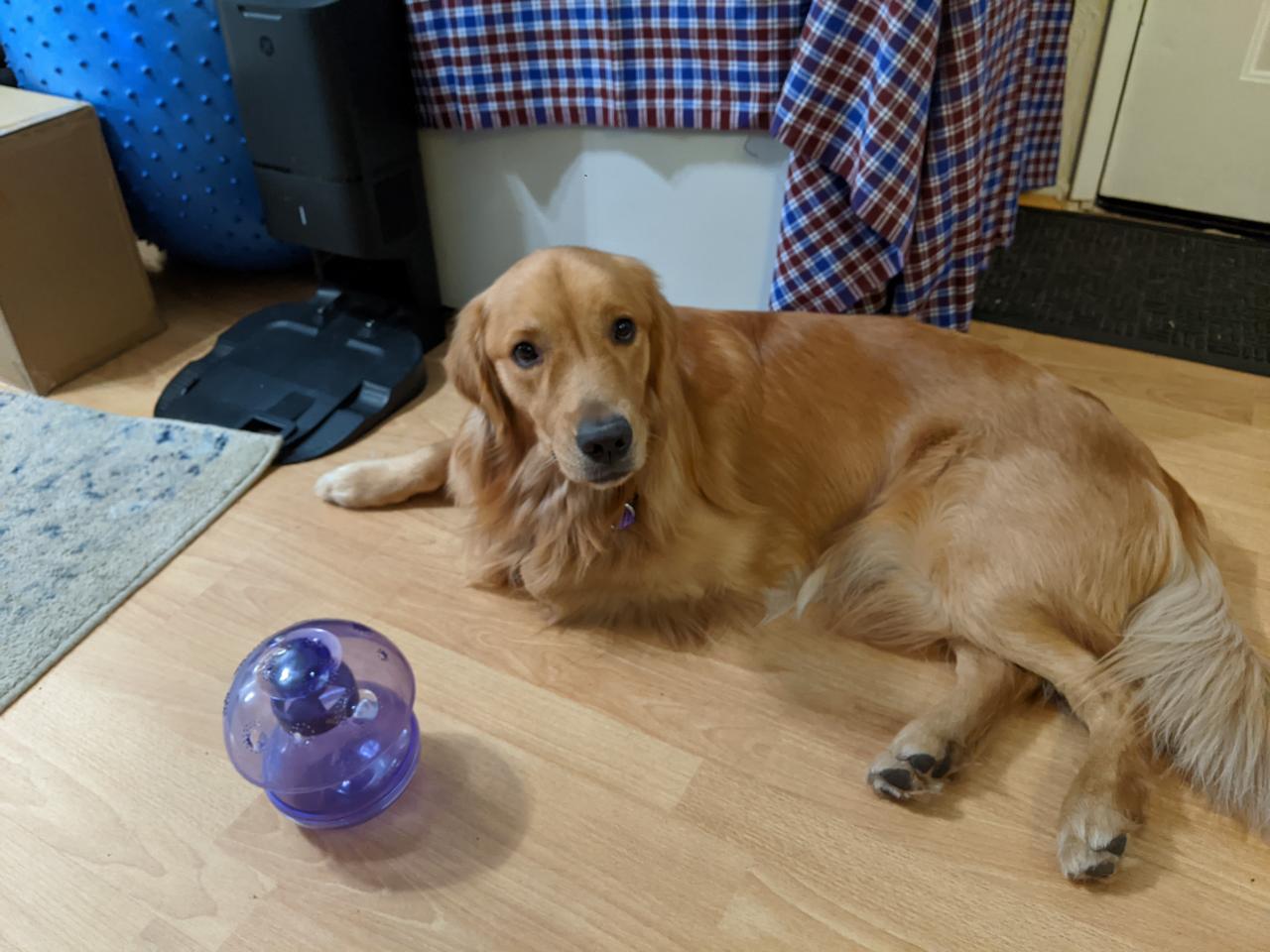
-
Orbee-Tuff Snoop Treat Dispenser - this one is soft (quiet), bouncy (fun), and lets the kibble out with moderate effort (medium difficulty) - good for slowing down feeding and extending meal ‘play time’, but probably not tough enough for a dog with a ton of energy or a need to chew/tear.
-
Lickimat - These are fantastic tools for cats and dogs of all ages! Some of our ‘tough chewers’ have caused damage to the normal lickimats (yes, even supervised), but they have a series of tougher ones we haven’t personally tried yet. Check out our recipes for ideas.
-
Starmark Bob-a-lot - The name is no lie - it Bobs a lot!! Built like a buoy, our dogs enjoy whacking at this with their paws to watch it swing/spin/dip, or nudging it with their noses when they’re less excited. It’s slow-to-fill, and can only hold smaller kibble sizes, but it is well made and very entertaining overall. Some dogs find it very intuitive, while others need a bit more of a tutorial, so we rate this as a ‘medium’ difficulty puzzle.
-
KONG Rewards Tinker - okay, okay, we partially like it because it looks like a tesseract.. but it also has lots of channels for the food or treats to wiggle through, making the puzzle a bit more work than it would seem at first glance. Not a sturdy toy for chewers and not super easy to clean, but highly recommended by our advanced yet gentle puzzle users.
-
- KONG Wobbler - Big enough for a large meal, fast to fill, tricky to empty, and able to go through the dishwasher? We’re in love with this wobbler. It’s beginner-friendly, but fun for advanced puzzle solvers, too.
Dog Fitness
-
Fitpaws fitness gear - a spectacular way to help puppies and dogs try new things in a safe environment, build confidence, and burn off some of their energy reserves. As with all fitness regimes, be sure to discuss any changes with your veterinarian and go slowly!
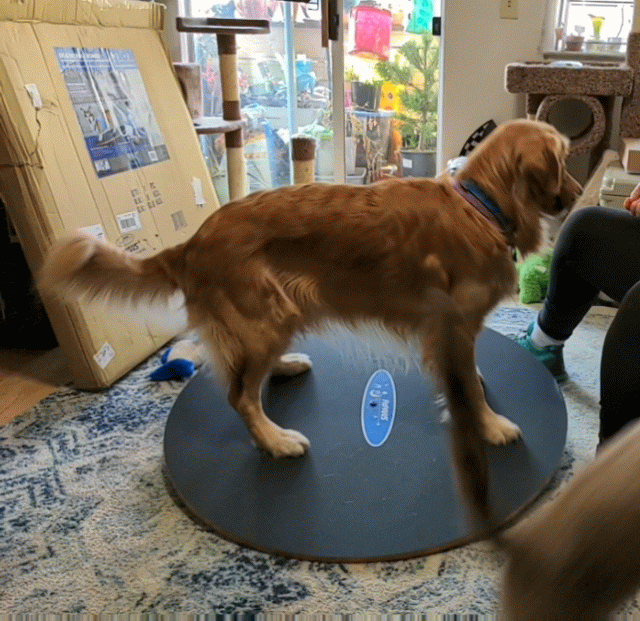
-
The Klimb platform with safety plugs for puppies and/or small dogs - we have found the Klimb to be an amazing tool that all our rescue dogs, foster dogs, puppies, and clients’ dogs have taken to amazingly quickly. For confidence-building, focus, and advanced concepts, this tool is portable, easy to clean, and extremely solid.
-
Paw targets - an upside down rubber livestock feed bowl works wonders and can be ordered from tractor supply or purchased at your local feed supply shop.
Interactive Toys
-
Teaser poles (aka flirt poles) - these come with a warning: don’t encourage young puppies or dogs to repeatedly leap, twist, or make sudden stops or turns. Play on soft ground (like grass or dirt), and keep play sessions short to help prevent injury. Folks say trainers love these, but veterinarians and rehab therapists hate them, so be careful!!
-
Puppy-friendly tug sheepskin with bungee - there are several great tutorials on how to teach your dog or puppy to play tug without encouraging bad behaviors or habits. Remember to limit tug duration and intensity during teething to prevent injury to your puppy.
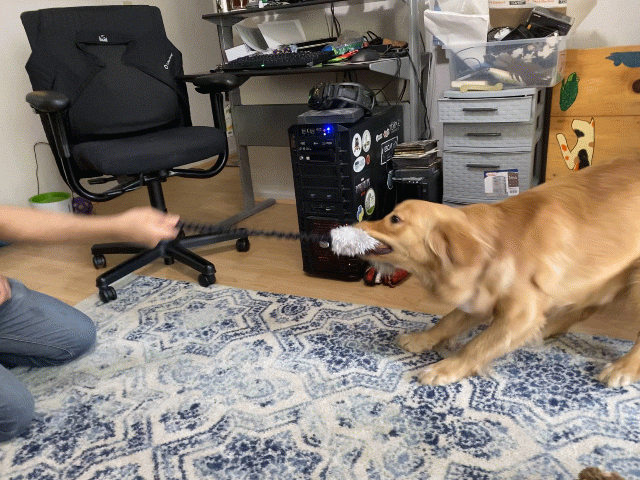
-
Pocket tug - bit o bunny - Dog Dreams Toys makes incredibly high quality tugs in faux and real fur. We love this pocket-sized tug for rewarding dogs who don’t know you’ve got a tug stashed somewhere.
-
Toss & tug toy: huck-a-cone - A surprisingly durable toy with an erratic bounce that’s sure to keep your dog interested in ‘the chase’. Check it out ‘in action’ here
-
Calmr Dog Toys - Weighted tug toys, settle straps, and more. We love these well-made, well-thought-out products! They also help support shelter dogs and continue to research ways to help dogs find balance.
Rolling or Fetching Toys
1.The Fetch Fix - a wonderful alternative to balls, this erratic bouncing square floats and is one-size-fits-all, truly! Small mouths can pick it up, too. The only thing we’d like to see is a larger selection of colors (glow in the dark? light up? bright pink in the grass? yes, please!). Made in the USA, too!
-
Chuckit Indoor tumbler - great for playing fetch in indoor spaces or for any time you need a softer surface. This style comes in a ball shape, too, but seems easier for the dogs to carry as a tumbler. It randomly goes out-of-stock, so look for it on Chewy, too.
-
JW Hol-ee-roller - great for puppy and dog play, and useful for enrichment activities (hide food and other toys inside). This is not a toy for a heavy chewer.
-
Chuck-it Breathe Right Balls - a much safer alternative to tennis balls, the ChuckIt Breathe Right allows dog to freely pant while retrieving. A fun texture, but definitely not for a dog who loves to chew. We’ve washed them on the top rack of the dishwasher without issues.
-
Hartz DuraPlay Dog Ball - Yup, it’s a bacon-scented squeaky ball.. which means it’s amazing for engaging a reluctant dog in fetch, but it’s also highly valued by most dogs and could cause trouble in a multi-dog situation. So far, it’s stood up well to our supervised play sessions, which is flatly shocking from the feel of it. Bravo, Hartz. PS - it gets super slimy quickly, and doesn’t really fit in any ball-launching devices; prepare yourself mentally for that joy.
-
Chuck-it Glow-in-the-dark Balls - These glow great after a quick charge from a UV LED brick or flashlight - perfect for fetch after work on these long winter nights. These have holes in them and are a little softer than some chuckit balls, so they tend to whistle when you throw them (our dogs love this feature) and also let the dogs get a good ‘squish’ when they chomp down. We’ve washed them on the top rack of the dishwasher without issues.
2.Nite Ize light-up frisbee - this one is for soft mouths, not chewers! It is bright, easy to toss, soft for the dog to catch, and has a replaceable battery. Nite Ize also makes great light-up collars, leashes, and little tab lights, plus a decent compact water bowl.
- Chuckit Hydrofreeze - outstanding for beating the heat on those summer afternoon fetch marathons. it’s a bit tough to get in and out of the freezer sleeve, but otherwise 4/4 toe beans - definitely recommended!
Chews
- Benebone puppy & dog
- Nylabone - note there are various levels of ‘hardness’ so steer clear of tougher levels for young puppies.
- Wool toys
- Starmark everlasting treat wheeler
- Raw, frozen bison bones
- Buffalo horns
- Antlers (Elk or deer)
- No-Hide
- Gorilla chew
- Himalayan Cheese Chews
- Beef Trachea
- Bully Sticks
- Unwrapped Bully Sticks
Creating Puppy-safe Spaces
-
Crates - Much like a crib, a crate can help keep puppies and dogs safe as they learn how to interact successfully within our homes. All dogs should be crate trained because crates and kennels are used at animal shelters (if your pet is found), veterinary hospitals, boarding facilities, and grooming facilities. You want your puppy to have positive, calm associations with crates, and that starts at home with practice and patience!
-
Exercise Pens (aka X pens) - a great way to create puppy ‘playpens’ is with an “X pen” - they come in a variety of sizes, and fold neatly for storage when not in use. Particularly if your home has areas that are not puppy-proof-able, exercise pens can provide safe enrichment areas for your puppy.
-
Baby gates - another way to help ‘puppy proof’ your home is by using baby gates. We love the carlson pet product gates because they offer flexible mounting hardware, come with and without cat doors, have multiple configurations, and they even come in a variety of colors. What’s not to love?
-
Assorted ‘baby-proofing’ gear - cabinet locks, pantry locks, socket protectors, and even door keepers are readily available in many stores for ‘baby-proofing’; they work great for ‘puppy-proofing,’ too. Don’t hesitate to use these tricks with older dogs - it’s all about avoiding an emergency vet trip!!
Dog Beds
-
Coolaroo Dog Bed - a great way to keep stress off of elbows, hips, and knees! Most dogs love these during warmer months, and our puppies have enjoyed bounding on & off them like a trampoline, so we know they are tough! They are also easy to hose off outside to clean.
-
Friends Forever Orthopedic Bed - by far our elderly Shepherd’s favorite bed. The one drawback is that it is not simple to clean, so probably best to keep it away from young puppies, or find a waterproof covering to protect it.
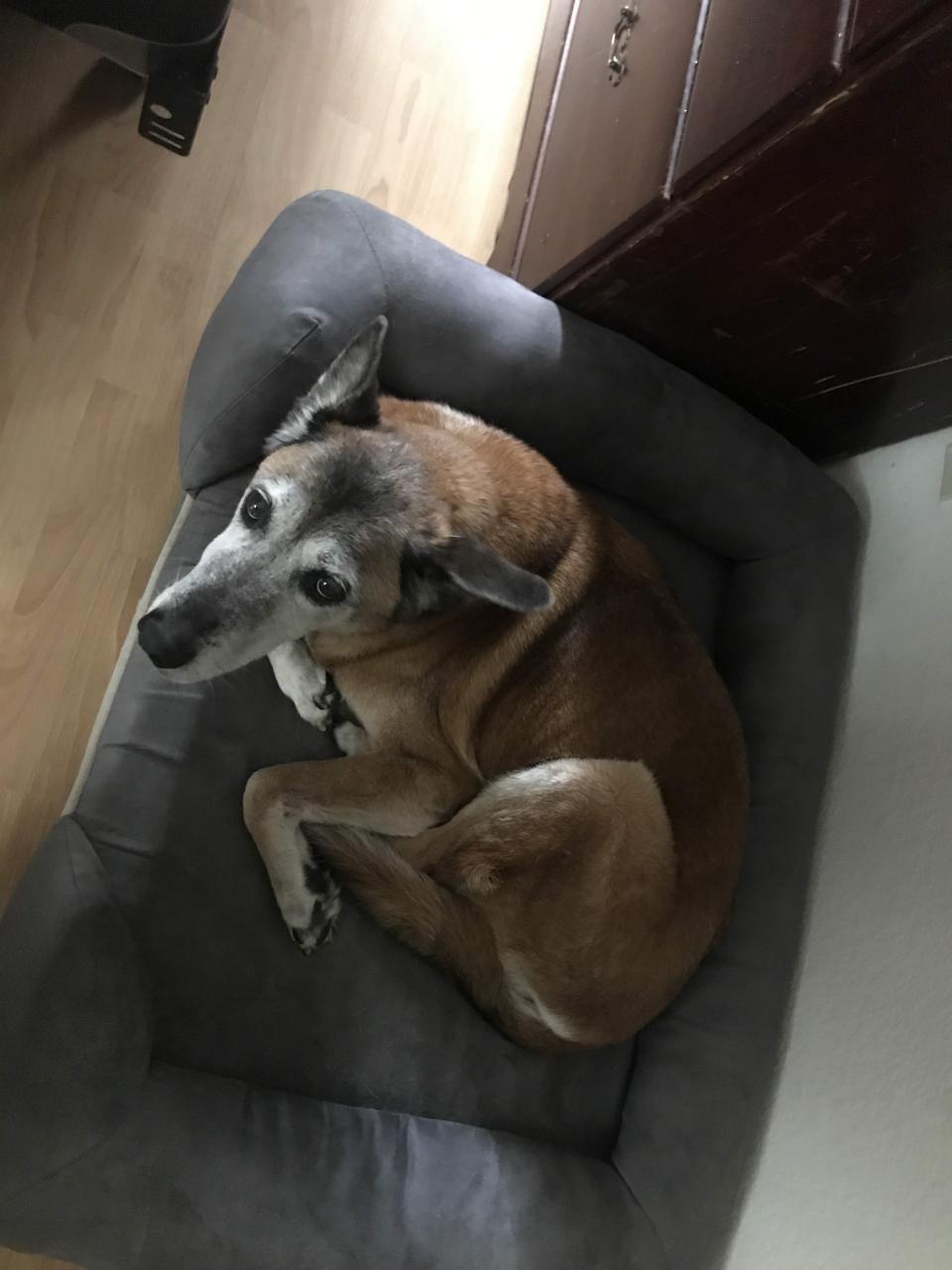
Leashes & Collars
-
Lupine Reflective Collars & Leashes - Lupine makes great quality stuff, and their latest line of reflective fabric is incredible. It increases visibility and is still backed by their amazing warranty. If you have a particularly fluffy friend, check out their ‘Collar Buddy’ contraption - it’s rather spectacular!
-
A 15ft cotton or biothane longline - I’m divided on which material I like best for a longline. Both will give you rope burn and can trip you, so be aware when using them! While you’re adjusting to handling a longline, secure it to a harness to prevent accidental injury to your puppy. If you’re handling your puppy in dry or wet conditions, a cotton line is softer in the hand without being slippery and it is less likely to get snagged on smooth surfaces (your jeans, your shoes) but more likely to get snagged on rough surfaces (tree bark, bushes) than a biothane line. If you’re handling your puppy in wet conditions with sand (especially the beach), a cotton line will feel like holding sandpaper (0/5 stars)! Biothane is simpler to clean, but often more interesting to a puppy to chew. We keep both around for a reason. There are longer longlines (20ft, 30ft, 50ft), but I find the 15ft is a great length for your puppy without being a headache of length to manage for you. If you do need a longer line to train with for advanced exercises, your local dog club, breed club, or trainer will often have one to borrow.
-
Light-up collar - The nitehowl ‘necklace’ is bright, rechargeable, and comes in a rainbow option that really grabs the attention of passers-by. It is trimmable for a better fit than most LED-strip collars, which we love.
-
Nox gear Lighthound light-up harness - We love, love, love this harness. It’s bright, washable, and rechargeable. The only down side? it’s easy to chew the side straps, so don’t leave it on unsupervised! For puppies who will grow into big dogs, we’ve found you can order the correct adult size and improvise the fit on your puppy.
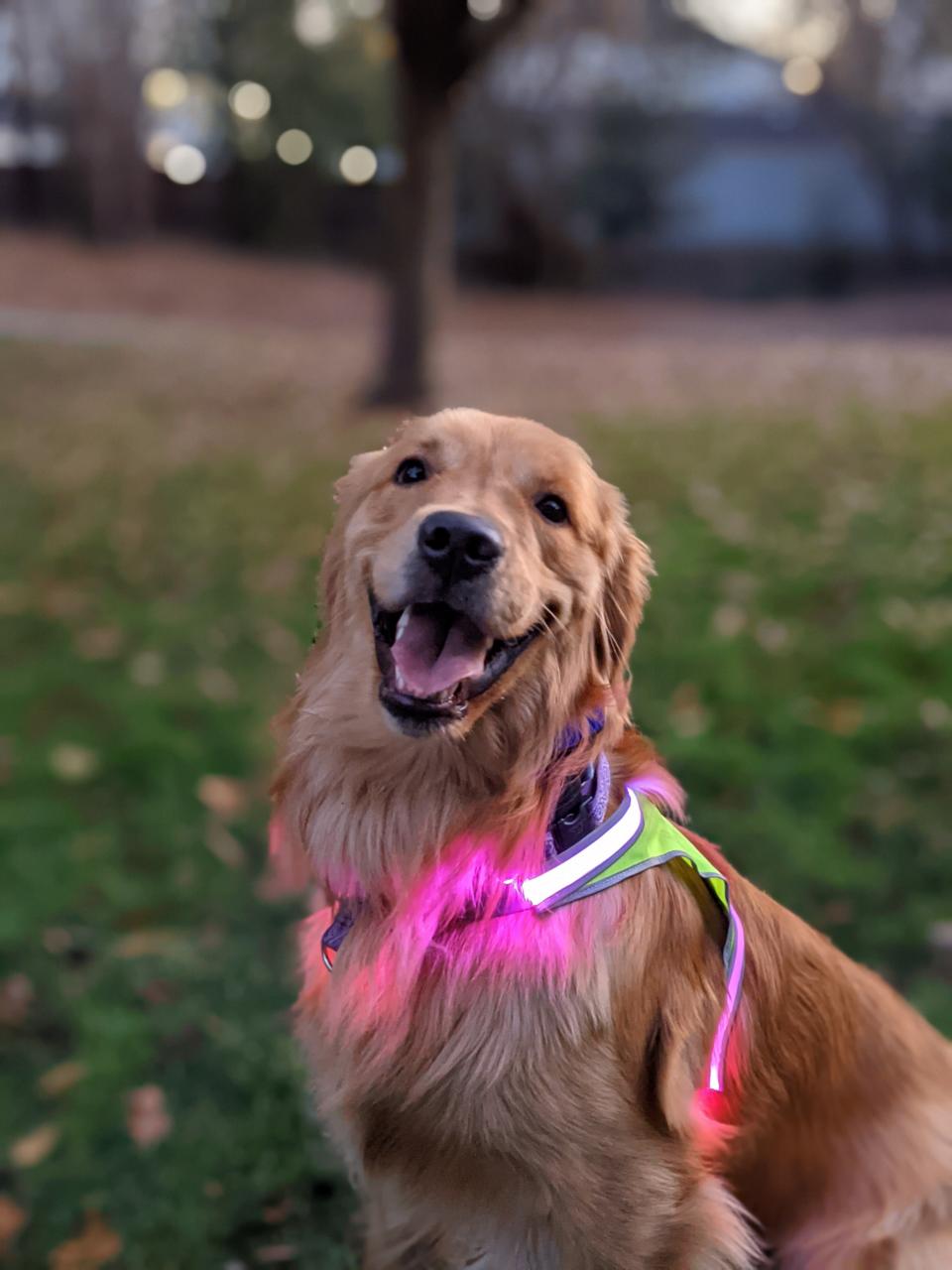
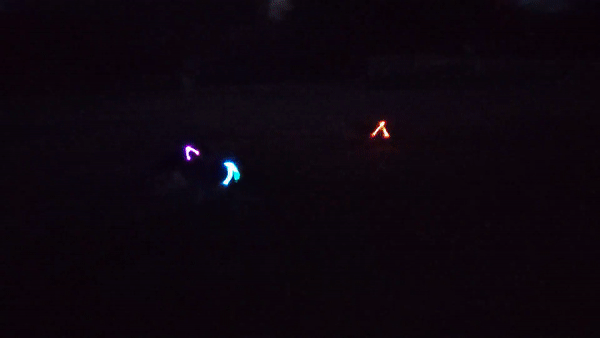
- Hagen Dogit Harness - I am a firm believer in the saying, “harnesses are for pulling.” With that said, harnesses still have many great uses in dog training! We love the ‘easy on’ and solid construction of this harness. It’s perfect for helping puppies/dogs with stability when they’re starting to use fitpaws gear, too. I use it with any ‘flight risk’ rescue dogs in addition to a standard leash with a collar or a slip lead.
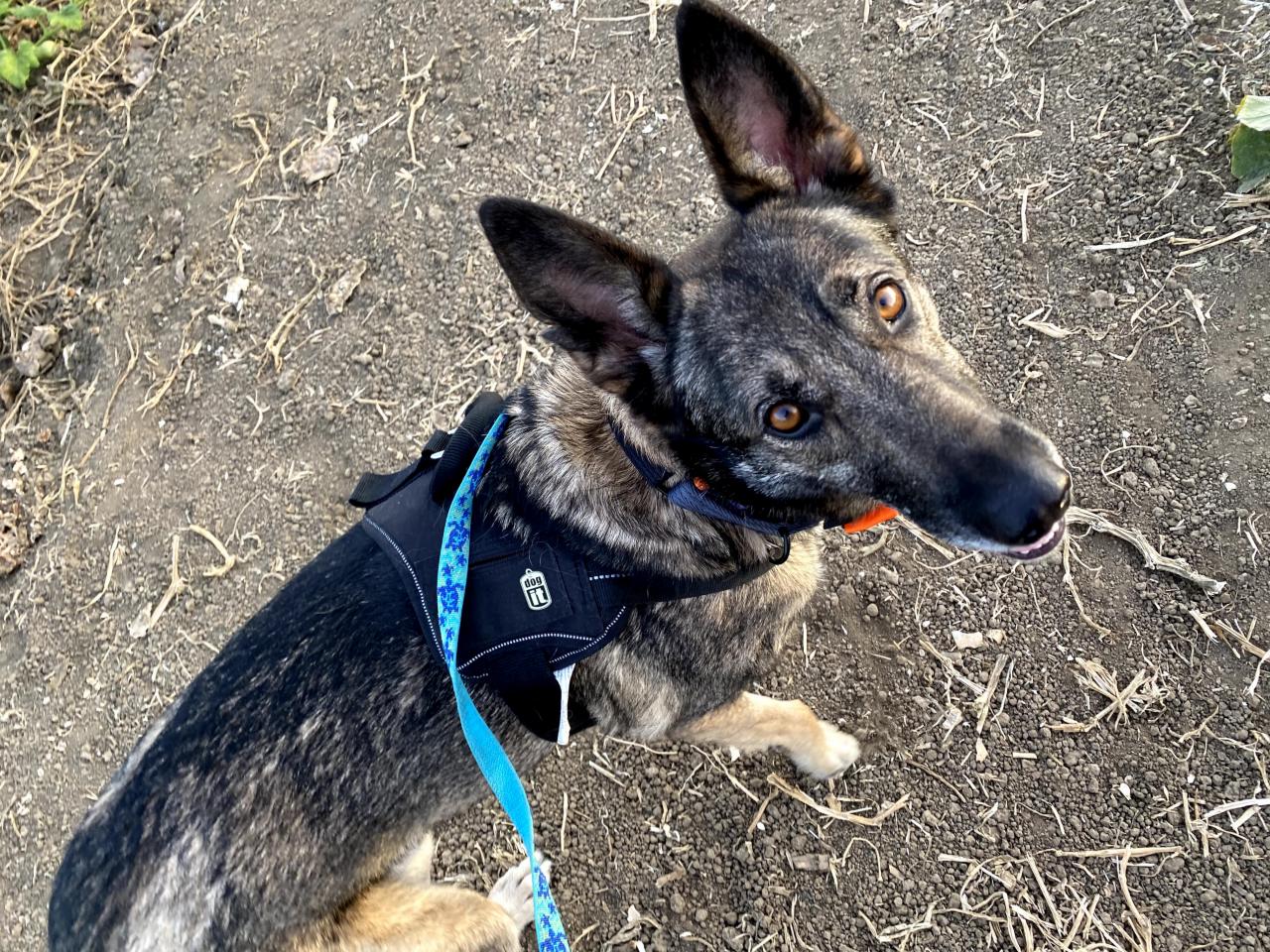
-
“Houselines” - a vital puppy tool for in-home exploration is a ‘houseline’. The simplest option is to buy an inexpensive ‘cat leash’ and cut off the handle. Crafting your own from ~1/4” nylon rope and a sturdy snap is great, too. Either way, it gives you a quick leash to grab inside to redirect the puppy from mischief. A good houseline can also help an older dog learn boundaries and be more successful at house manners.
-
Pull-tabs / Training tabs - When transitioning from longlines to off-leash, a training tab can be extremely useful. Short enough not to trip most medium/large dogs while still giving you a handle to grab if an unexpected distraction comes by on the trail or during advanced training exercises.
-
Leash ‘safety’ lines - particularly when working with a new training leash or device, it’s a great idea to have a safety clip connecting the new tool to your regular flat collar. These usually have a short length of nylon connected with a snap on each end. Highly recommended if you’re training out in the real world where an accidental ‘loose dog’ moment can be very dangerous for the dog.
Grooming Tools
All tools will vary in usefulness depending on your pet’s coat, length, and sensitivity to touch. Introduce all new tools slowly, calmly, and with lots of praise for calm/curious reactions. Never leave grooming tools unattended with your pet.
-
Furminator Nail Dremel - We love, love, love this tool! Because of the shape of the nail bed, many dogs are sensitive to nail clipping, but the nail grinder never puts any pinching pressure on the nail. The safety ‘stop’ and guard on this tool are my favorite, plus the battery life is decent on the portable one (I use it for puppy classes). If a proper introduction is done with this tool, you’ve got a good chance of easy nail trims for a lifetime.
-
DiamondG nail grinder - if you have lots of nails to keep tidy, nothing beats this professional grade dremel. It’s newest version has USB-C charging, and sealed bearings. It’s heavy duty, but so is it’s initial investment.
That said, I have never met a cat who loved a nail grinder. So for cats, lizards, rabbits, rats, guinea pigs, etc., I would still have a set of quality small animal nail clippers on hand. I prefer the ones that open and close like scissors, but try several types to see what’s most comfortable in your hand. The better you are with them, the faster you’ll trim, and the less your pet will notice.
-
Styptic powder - while this can also go in the “first aid” section, whenever you’re cutting nails (or fur), you should have styptic powder nearby. Cornstarch or flour can do in a pinch, but actual styptic powder is much easier to use.
-
Quality slicker brushes - a good slicker brush has quality bristles that don’t bend or break and a base that doesn’t rust. It should feel even and smooth when you run it along your arm, and not poke-y or too scratchy. These are great for gentle brushing and for collecting extra fluff off cats and dogs, but may be too intense for young puppies or sensitive individuals. If you’ve got a poodle or doodle coat, you’d be wise to upgrade to a more professional version
-
Baby wipes - the mildest, unscented ones you can find. I use them for ‘oopsies’ that stick in fur. Keep them in the car, by the litter box, and by the front door to keep everyone safe from unexpected poopsiedaisies.
-
Pet shampoo & conditioner - there are so many choices out there! My only preference is to use (human) tear-free baby shampoo if I’m washing a pet’s face. Otherwise, try well-regarded brands to see what makes your pet’s skin and coat look and feel healthy.
-
Detangler - for in between bath time, it’s great to have a detangler spray if you have a medium- to long-coated breed. Cats tend not to love being sprayed, but if you spray the brush instead, it can still make a big difference in coat management.
-
Grooming gloves - I like grooming gloves for short-coated pets during our weekly grooming ritual. You can use them in the bath, too, but I prefer to feel my pet’s skin to make sure there are no areas of concern.
-
Quality shedding blade - shedding blades seem to work best on our short-coated pets, but they are rather magical for German Shed-ers and horses & ponies when they’re shedding their seasonal coats.
-
Electric clippers - an important tool for grooming many coat types, clippers can also remove fur around cuts and insect bites to help ensure your pet is healing properly. Exposing your pet to the sound of electric clippers when they’re calm and happy is a great idea even if you have no intention of clipping their coat for the moment. If you’re facing a monthly shave, consider professional grade clippers like the wahl bravura and keep your blades clean, well-oiled, and dry for the most bang for your buck.
-
Chlorhexidine - a spectacular antiseptic that can be useful in so many ways. It’s our go-to for reptile and amphibian habitat disinfection, tear-free skin abrasion cleanser, and diluted it works great as an all-over wipe down for pets with severe allergies to help remove the pollen that sticks to their fur.
Miscellaneous Dog Accessories
-
Portable water bowl - there are so many options, it can make it tough to choose. So far, the Gulpy has been the best ‘moderate’ amount of water with built-in bowl. We also dig the collapsible drinking bowls linked.
-
Baskerville muzzles - Every puppy/dog should be exposed to a muzzle in a calm, positive way. Muzzles can be necessary when dogs are badly injured (or for lots of other reasons), and you never want your dog’s first experience with a piece of equipment to be under extreme stress. Most dogs will go their whole lives without needing a muzzle, so a couple of early, positive associations is a sufficient baseline to help make any future emergencies simpler.
-
Outfoxed hood for dogs - these are amazing for folks living in areas with “Foxtails”, which can cause serious medical emergencies for your pet. Just like the muzzle training, you want your puppy or dog to learn to love this piece of equipment before you go outside on a hike with it.
-
Doggie backpacks - As with all exercise and fitness goals, be sure to discuss backpacks and appropriate weight carrying with your veterinarian before beginning any training. A proper fit is the most important part of a good backpack, so definitely use your best judgement when picking one for your dog; check often for any soreness or points of friction. We love the Canine Equipment Ultimate Trail Pack because it is well made, multi-point adjustable, and the panniers are easily removable. Because of the removable panniers, you can let your young puppy or dog carry the empty harness long before they’re ready to carry panniers and/or any actual weight - a very valuable training feature. If you want a close fit, and even weight distribution for excellent doggie fitness opportunities, try xDog vests
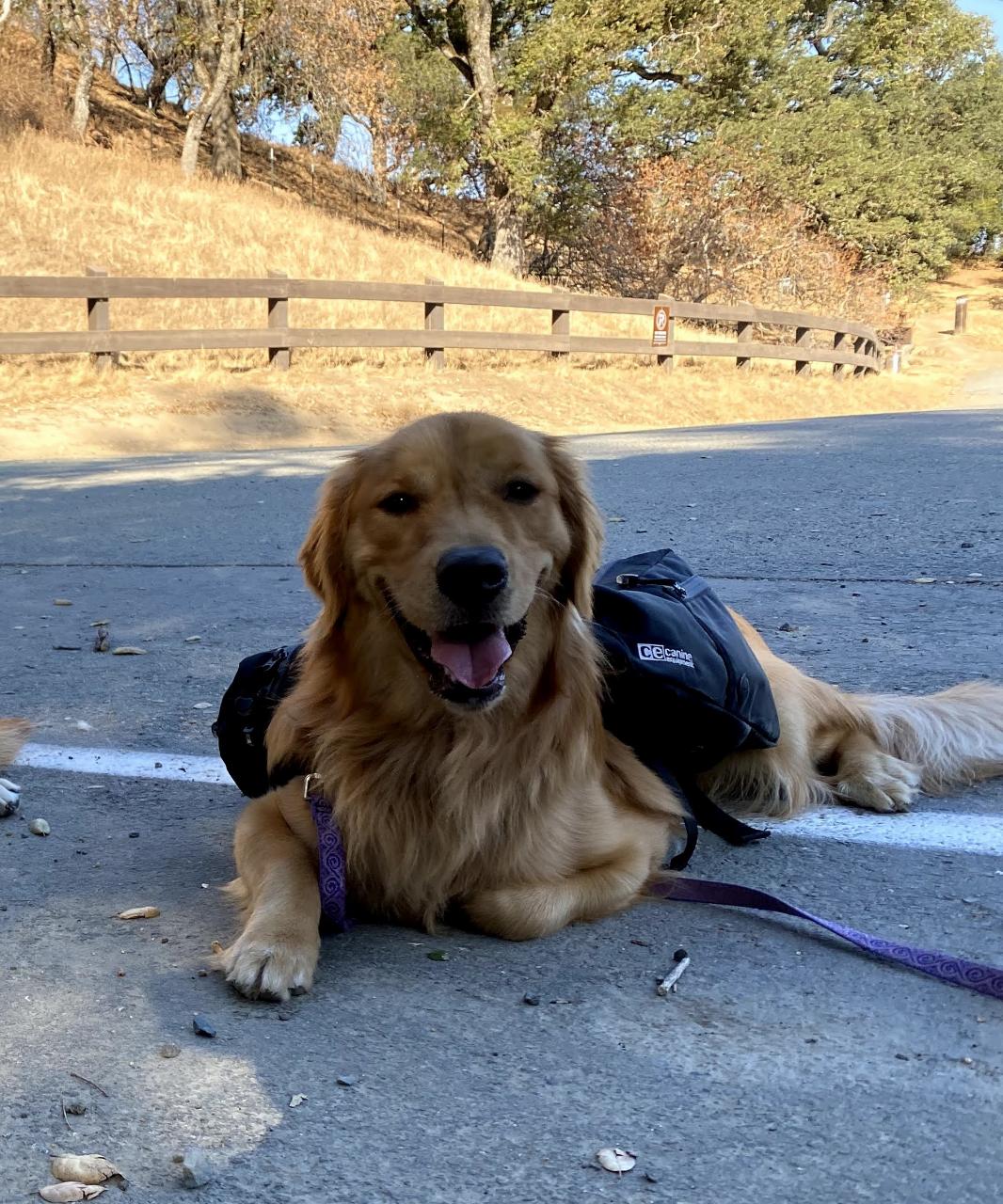
-
Ruff Rescue Gear - taking your pet on adventures always comes with risks, but with this compact, light-weight harness, you can go boldly knowing you’ve got a lifeline. If you encounter unexpected hazards like rough trails, a lengthier trail than expected, or even an injured pet, this harness makes it easier to get everyone home. We also find it great to have in our packs to avoid over-hiking with puppies or elderly pets while still allowing our best buds to enjoy the trail.
-
Help-em-up Harness - these are amazing for older dogs who need help getting up into vehicles, or even a little help walking around. They are also wonderful tools after surgery. A bit tough to get the fit correct, but once it’s adjusted, it’s life changing for both owner and canine.
-
Doggie Life Jackets - Plenty of dogs are excellent swimmers and don’t require assistance during ideal conditions, but for dogs who have shorter faces, older dogs, young puppies, or dogs on motor boats, a life vest is an important tool. Just remember, we humans wear life vests in case of accidents, not necessarily just if we cannot swim.
-
Doggie Raincoats - if your puppy or dog is prone to soaking up a lot of water, a raincoat may not just be adorable - it may save you a lot of time. When dogs get wet, particularly in cool or colder conditions, they can be susceptible to hypothermia or other serious medical issues. If you forego a coat, be sure to dry pets thoroughly with towels and/or a cool/low-heat blow drier. A raincoat with a flap that wraps most of the belly will also help keep dogs from kicking muddy rainwater up onto their coat, which makes cuddling them less gritty later. Want even more belly coverage? Try Canada Pooch Complete Coverage
-
Doggie Rain boots - it sounds silly, until you’re tracking mud everywhere for months in the rainy season, plus they’re adorable. Be sure to introduce booties slowly, using lots and lots of praise and treats.
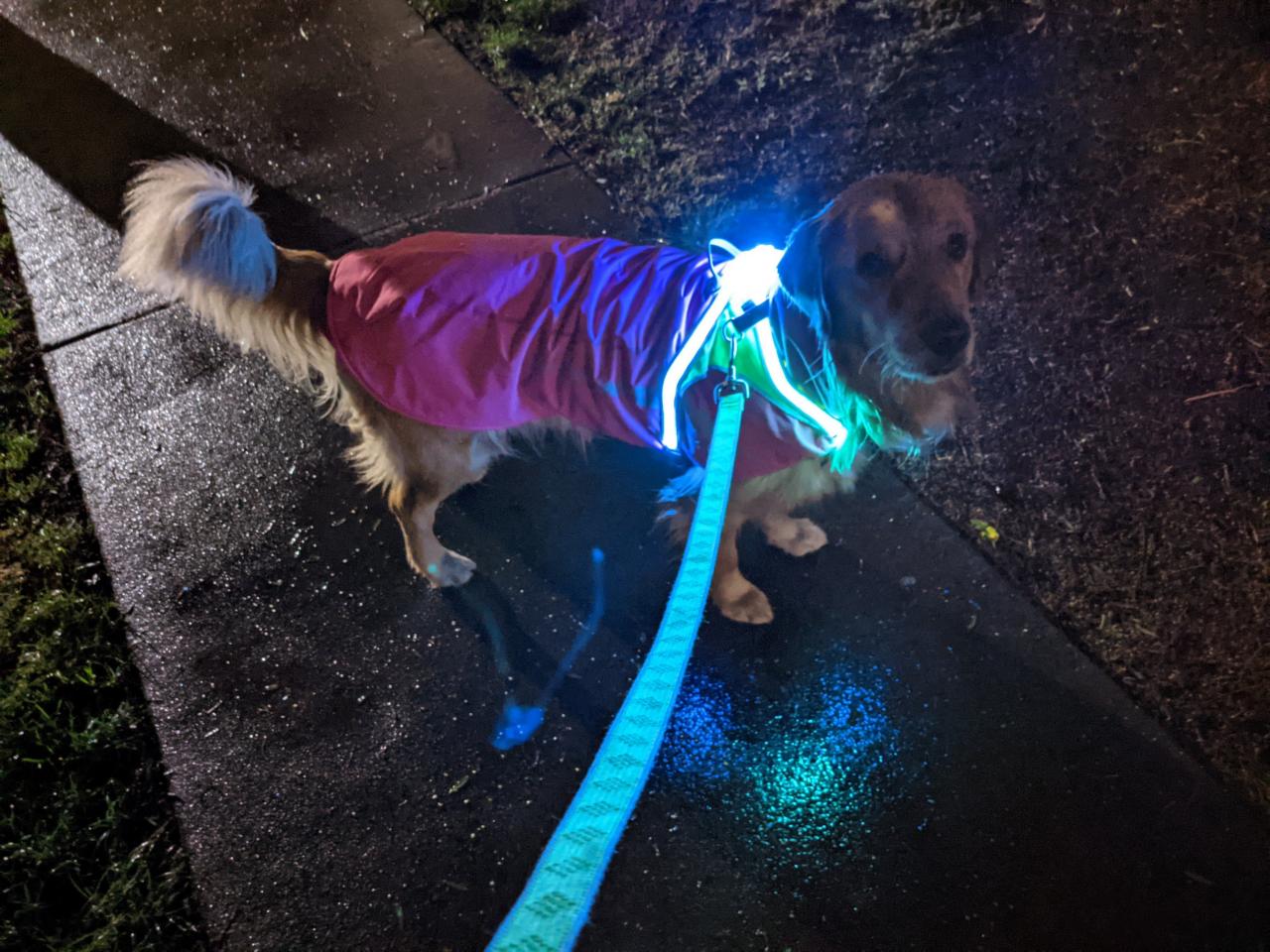
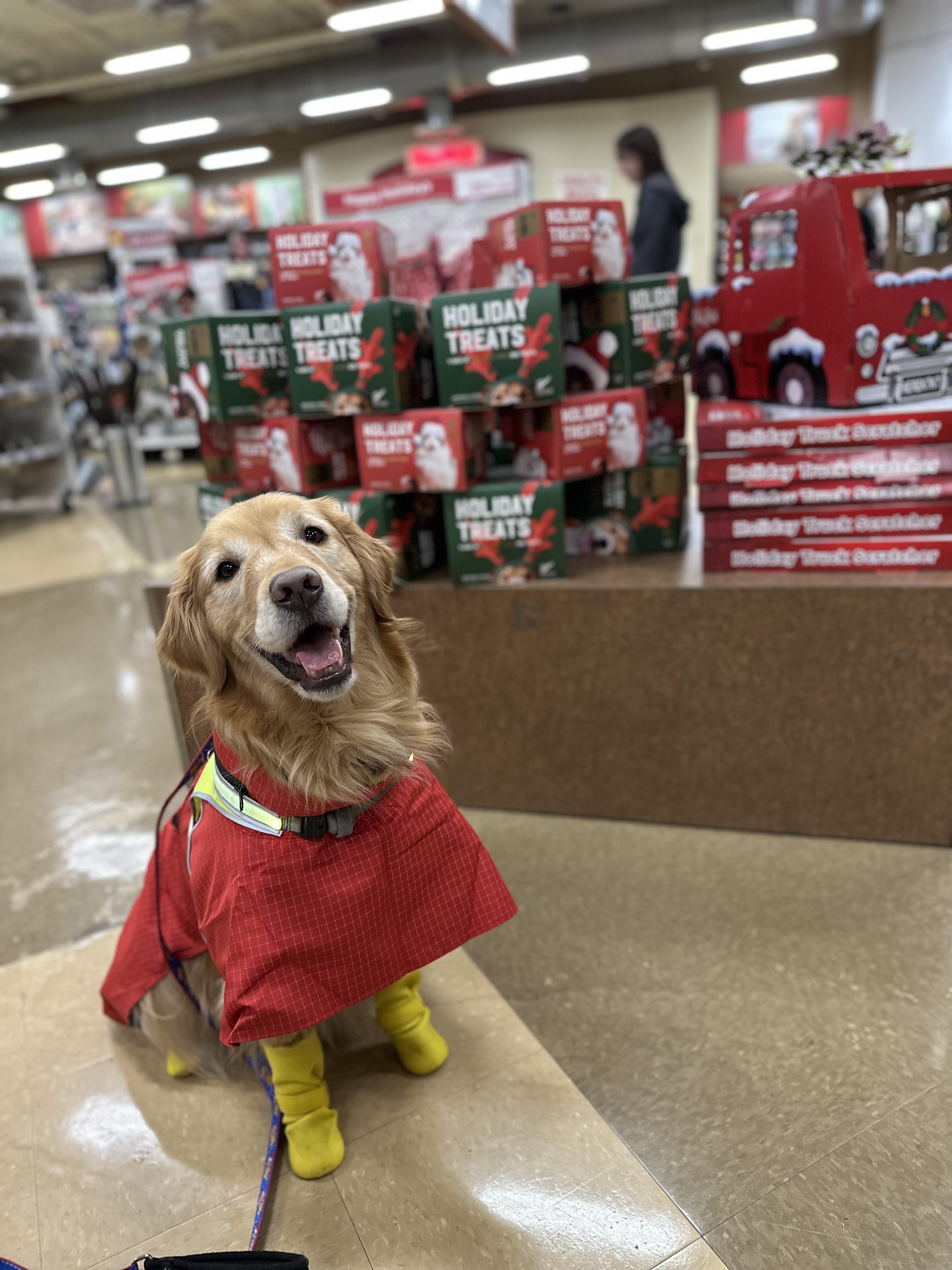
Trainer accessories
- Clickers
- Treat pouches
- Whistle (dog recall)
- Mini air horn (safety for walks)
- Luring poles / target sticks (for advanced tricks with both cats and dogs)
- Food storage - waterproof, airtight, and critter-proof
- Bissell pet spot-bot(for all sorts of.. occasions)
- Bells (for tricks or toilet training)
- Awesome Bolliam raincoat with ALL THE pockets!
Beat the heat (Summer-themed gear)
-
Cooling / Ice vest - our medium- to long-coated breeds need a little help keeping their core temperature down during summer, and we love the cool pups vest for the placement of cold packs right next to the dog’s chest. If you’re in the mood to customize, check out CoolingCoats!
-
Dog water fountains - For sanitary reasons, these need to be cleaned often even when they have filtration! We prefer ceramic to plastic or metal, but there are options out there for everyone. If you’re looking for outdoor solutions, check out K&H pet products for a cooling bowl.
-
Chuckit Hydrofreeze - outstanding for beating the heat on those summer afternoon fetch marathons. it’s a bit tough to get in and out of the freezer sleeve, but otherwise 4/4 toe beans - definitely recommended!
-
Portable water bowl - there are so many options, it can make it tough to choose. So far, the Gulpy has been the best ‘moderate’ amount of water with built-in bowl. We also dig the collapsible drinking bowls linked.
-
Musher’s Secret - great for keeping paws in tip top shape all year, but particularly important if you live somewhere with dry, hot summers. Any paw salve will do, but we’ve found this one to be mild, effective, and not too tempting for sniffers.
-
Doggie Booties - finally! A bootie we love for summer. These are breathable, and really stay put. They are not completely foxtail grass-proof, but they’re a great start.
-
Cooling pad - this pad has saved our fluff! Fill it with chilled water to make your dog more comfortable in warmer air temperatures.
-
Coolaroo Dog Bed - a great way to keep stress off of elbows, hips, and knees! Most dogs loves these during warmer months, and our puppies have enjoyed bounding on & off them like a trampoline, so we know they are tough! They are also easy to hose off outside to clean.
Beach trip?
Dog-friendly beaches can be a lot of fun, great exercise, and a superb bonding experience! Some dogs may feel overwhelmed, so go slow (and bring a familiar beach-savvy friend with them); other dogs will get so excited about beach outings that they can overdo it, so ask your dog for regular check-ins and monitor their temperature, too. Here’s our “Must Bring” list:
-
Fresh drinking water & bowl - whether you’re headed to a fresh water lake or the ocean, it’s important to offer fresh, parasite-free water and to monitor how much your dog drinks. Drinking too little or too much can make them very, very ill; Know the signs, and head to an emergency veterinarian if you believe your dog is exhibiting signs of water toxicity or dehydration. Plan to bring ~3x as much as your dog normally drinks during similarly active times, since a lot will be spilled, shared, or dumped due to sand.
-
A 15ft biothane longline - Most dogs aren’t ready to be off leash on their first trip to the beach, so this will give you a nice compromise between fun freedom and risky danger (practice before your trip, though!). All longlines can give you rope burn, wrap folks up, and even trip you, so be aware when using them! While you’re adjusting to handling a longline, secure it to a harness (smaller dogs) or flat collar (bigger dogs) to prevent accidental injury to your dog or puppy. If you’re handling your pup in wet conditions with sand (especially the beach), a cotton line will feel like holding fast-moving sandpaper, plus biothane is simpler to clean. There are longer longlines (20ft, 30ft, 50ft), but at a beach, you’re likely to encounter other people and dogs, so I find the 15ft is less of a headache to manage.
-
Towels - for you and the pups!
-
Picnic blankets/chairs/etc - it’s nice to have a ‘base camp’ near the water. If you start practicing at home, you can absolutely teach your dog boundaries around picnic gear to keep some of the sand/surf/dog fluff out of your sandwich. Many dogs will generalize this with a little encouragement, too, which keeps your dog from intruding on other people’s picnics, too. That said, I would be sure to bring a separate shade structure and towel or blanket for your dog to have a good spot to rest, too.
-
Waterproof collars and ID tags - if your regular collar isn’t beach-safe (leather doesn’t love soaking in water), be sure to have a backup plan to have identification on your pet at all times.
-
Treats/Dog snacks - if your dog loves running, fetching, swimming, and playing, be sure to give them options rest to refuel. Hikers/runners/athletes refer to excessive exercise without food intake as “bonking” or “hitting the wall”, and there’s no reason to teach your dog about this.
Cat-specific Gear
Sure, some of the gear in the dog section is useful for our beloved kitties as well, but some things are truly just for the cats
Cat Food Puzzles
-
Mouse-themed puzzles - Doc & Pheobe have stepped up the cat food puzzle game to a new, awesome level. Our younger foster cats and kittens have all completely fallen in love with these food puzzle mice.
-
Platform puzzle - with suction cups on the bottom, this puzzle prevents would-be-cheaters from shortcutting the game. We like it’s size and uniqueness, and most of our foster cats have taken to it quickly.
-
Wet food slow feeder - These are super fun, cute, and dishwasher safe. Admittedly, most of these go ‘missing’ for at least a few hours each day because they are ‘too popular’ and the cats and kittens steal them and hide them, but who doesn’t love a game of hide-and-seek?
-
Treat track circle - if your cat likes turbo scratchers, wait until they see this! Our only complaint is that it’s too easy to remove the light up ball at the base (and it’s definitely a choking hazard for pets and tiny humans).
Cat Fitness / Toys
-
Turbo scratcher - there’s a reason these have been standard cat gear since the 1990’s! Tough, easy to clean, and seemingly universally appealing to cats, these are great for your cat or kitten to entertain themselves. I would caution you that they are somewhat loud (especially at 3am) and that some cats are adept at removing the ball (which is absolutely a choking hazard to dogs and tiny humans)
-
SmartyKat Instincts Hidden Hijinks Electronic Motion - our cats are captivated by this one! A simple design that stands up to many cat attacks. It can be dragged off, and it does time out, but otherwise it rocks.
-
Yeowww Catnip Toys - the quality of these toys and the catnip therein is so far unparalleled. We have some that have lasted many years, even being machine washed, and still look new. Keep them ‘fresh’ by placing in a closed container with new catnip for a week, and BAM! it’s like a brand new toy.
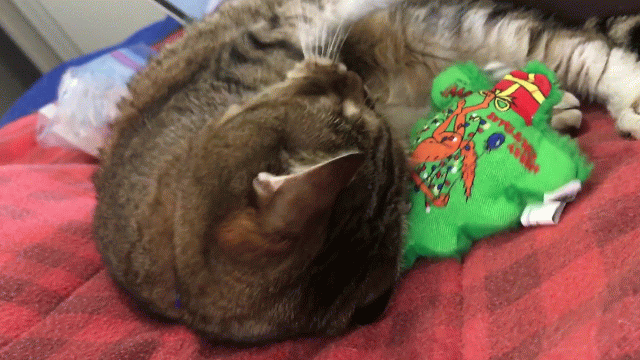
-
Toys - healthy cats love to play, so be sure to offer your cat or kitten a variety of toy shapes, sizes, and materials to find what they cannot resist.
-
Wobble Ball with Laser Pointer - whisker city knocked this one out of the park with this wobbling, fake-tweeting, laser wielding, feather wearing toy. Our foster kittens have all adored it, and our younger cats still play with it daily. It is loud enough to keep away from your bedroom or pick up at night, but with coupled with some rechargeable batteries (not included), it’s great fun.
Interactive Cat Toys
- Feather teasers - feather teaser toys come in many shapes, sizes, lengths.. the options are overwhelming! I prefer the rooster feather ends, maybe with a bit of shiny ribbon, and a long, flexible pole to give the end a real “bird flying” appeal. Keep these away from pets when not actively playing or you’ll quickly lose all the feathers (and if ingested, pay heavily to find them again via veterinary services).
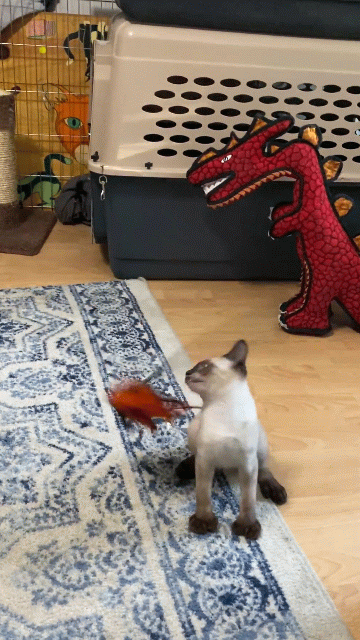
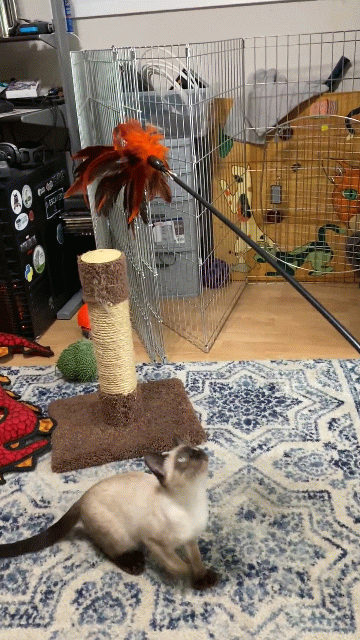
-
Laser pointers - unlike dogs, cats don’t seem to get laser pointer syndrome, though there is division amoung behaviorists. If you notice your cat becoming frustrated that they cannot ‘catch’ the light, discontinue play. I like rechargeable laser pointers best since the tiny, quickly-consumed batteries are hazardous to all those who live and breathe.
-
Cat teasers with fabric- our younger cats and kittens get so excited for this one; it just has a way of wiggling about that they love.
Cat Chews
-
Cat grass - the much coveted, often messy cat grass is usually wheat, and sometimes oat, rye, barely, or alfalfa. Consuming in moderation is normal, but if your cat cannot get enough, be sure to discuss it with your veterinarian.
-
Turkey tendons - you can often find these at feed stores or pet stores marketed to dogs, but our kitties love them enough to break into the treat tubs and steal the whole package.
-
No hide for cats - we didn’t know these were for cats until our cats stole them from our dogs. Turns out, the salmon and chicken ones come in smaller sizes for kitties!
-
Raw, frozen bones - again, primarily marketed to dogs, these meaty and marrow-y treats are also adored by cats. Be sure to monitor portion size and remove the treat if it is at room temperature for more than a few hours to avoid harmful bacterial growth.
Creating cat-safe spaces
Cats and kittens present unique challenges to ‘baby-proofing’ your home. They often enjoy, or even thrive, in vertical spaces. In an ideal world, any places a cat or kitten could get to would be safe (no exposed wires, holes in drywall, sharp objects, poisonous plants, glass that can fall and shatter), but even when pet parents do their best, critters often find a way to endanger themselves. For now, let’s talk about bringing your new cat or kitten home. Set up a smaller space (one room, a bathroom, a walk-in closet, or an extra-large dog crate) with food, water, a litter box, a few soft/cozy hide-away beds, and a pheromone spray or diffuser; this will give your new cat or kitten a chance to settle in before feeling overwhelmed by the whole house and its humans. How long does it take to ‘settle’? It will depend on the individual; be patient and be sure to keep visitors to a minimum for shy cats.
-
Cat pheromone diffuser - spectacular for cats and kittens whenever change or stress is expected. When we use these shortly before and after a move, the difference in recovery time (not hiding) is remarkable (hours vs days). Highly recommended for multi-cat households, new environments, new human roommates or partners, environmental turbulence (fireworks), or if you’re adding a new pet.
-
Indoor plant cabinets - convert an old book shelf into a plant wonderland and cat-free-zone with a few LEDs and a plexiglass door. I’ll admit that even hanging plants from the ceiling, I have had some individuals figure out how to get to them, so this is my most ‘solid’ cat-proofing idea to date. We also velcro (industrial velcro) metal screens to all our windows with plants to keep cats and plants separated.
-
Baby-proof cabinets & pantries - don’t let cats sneak in and get into chemicals under the sink or toxic food items. Even if you believe you use ‘wholesome’ products, I guarantee you don’t want your cat ingesting them or getting them in their eyes.
Cat Beds, Trees, & Nests
- Window-mounted cat beds - K&H has a variety of window or glass-door mountable cat beds to suit most feline’s desires. We’ve found them to be extremely stable and well-loved.
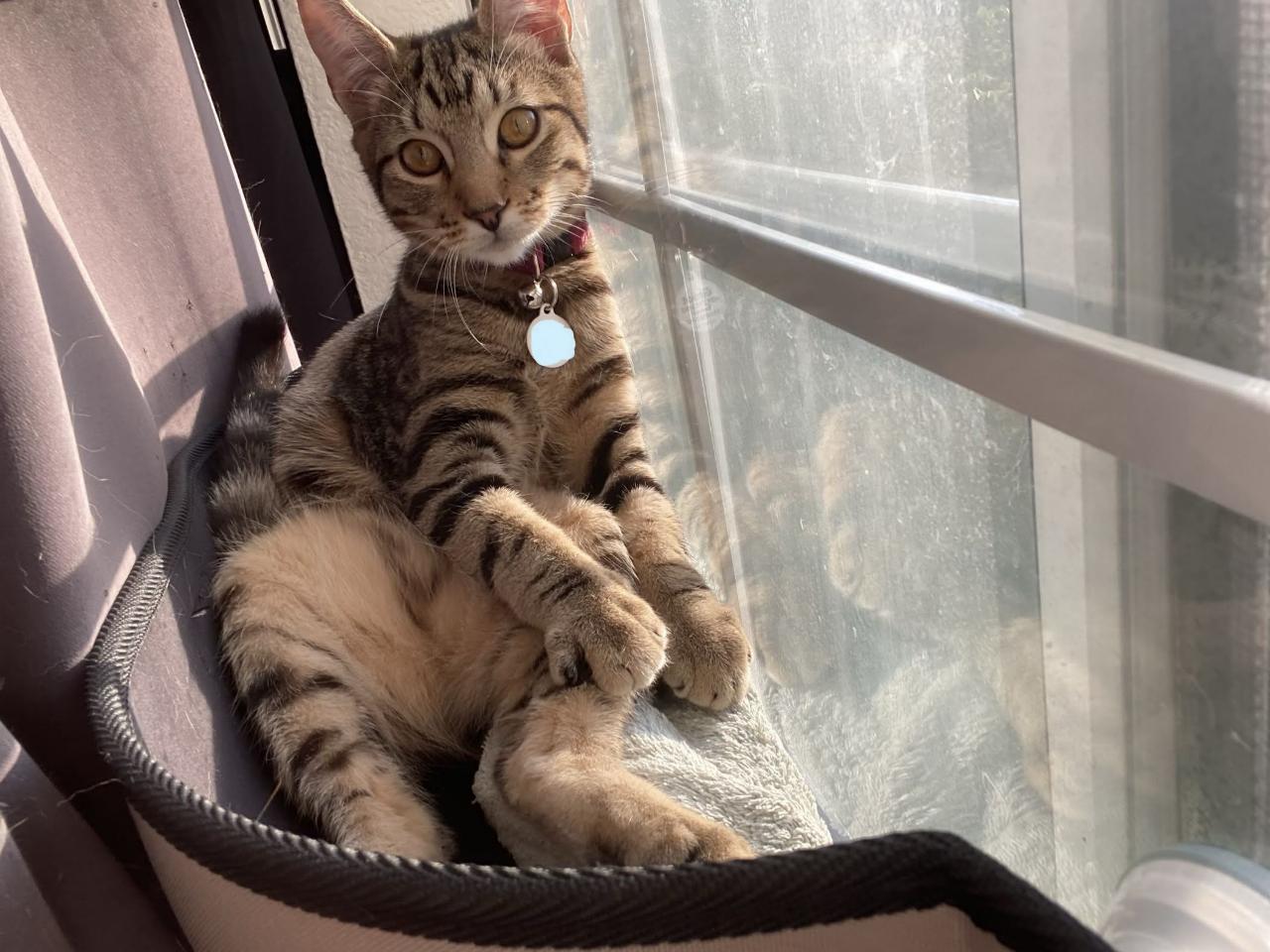
-
Heated indoor mats - my only regret about these is that we didn’t get one sooner. From elderly cats to kittens, everyone loves these pads. Easy to wash the cover and foam, too! Equally popular with our felines, the ‘space ship’ heated bed.
-
Door-hung “cat tree” - We love to give our kitties lots of places to zoom, climb, hunt, play, explore, and avoid stress, so this unique ‘cat tree’ was a must! We coupled it with an extra tall scratching post to give easier access up and down to younger kittens. Stuff a little packing paper sprinkled with catnip (or littered with their favorite toys) in it to create a wonderland.
-
Classic cat trees - the internet can show you cat tree configurations for days, so let’s talk about how to pick ‘the right’ tree for your feline friend. Consider how your cat plays - do they love running across partially-unstable surfaces (the bed, the couch)? leaping? climbing? hiding and ambushing? Or just snoozing on top of the refrigerator? Picking a cat tree with the right attributes to match their play style will help them get the most out of it. Also be wary of internet purchases - sometimes the scale is quite different in the pictures! Check dimensions in descriptions and look for customer reviews. A poorly made tree that falls or collapses could be scary for and/or dangerous to all of you.
-
Tunnels - you can always improvise tunnels for cats and kittens by hanging towels, sheets, or drapes over portions of the furniture, but having designated, permanent cat tunnels can also be fun. Get creative and use them to connect cat towers and prime nesting spots for ‘stealth panthers’ to navigate.
-
Laundry baskets - grab a moderately sized square laundry basket from any old place, add a heavy blanket or throw to the bottom, a pillow, and maybe a soft towel or blanket on top (plus a heating pad, perhaps?) and you’ve made a spectacular sleeping nest that won’t get your clean clothes fuzzy. Be sure to launder the top layer weekly to keep the kitty interested in nesting. Adding toys, catnip, or even treats hidden in the top most layer can also provide foraging and fun.
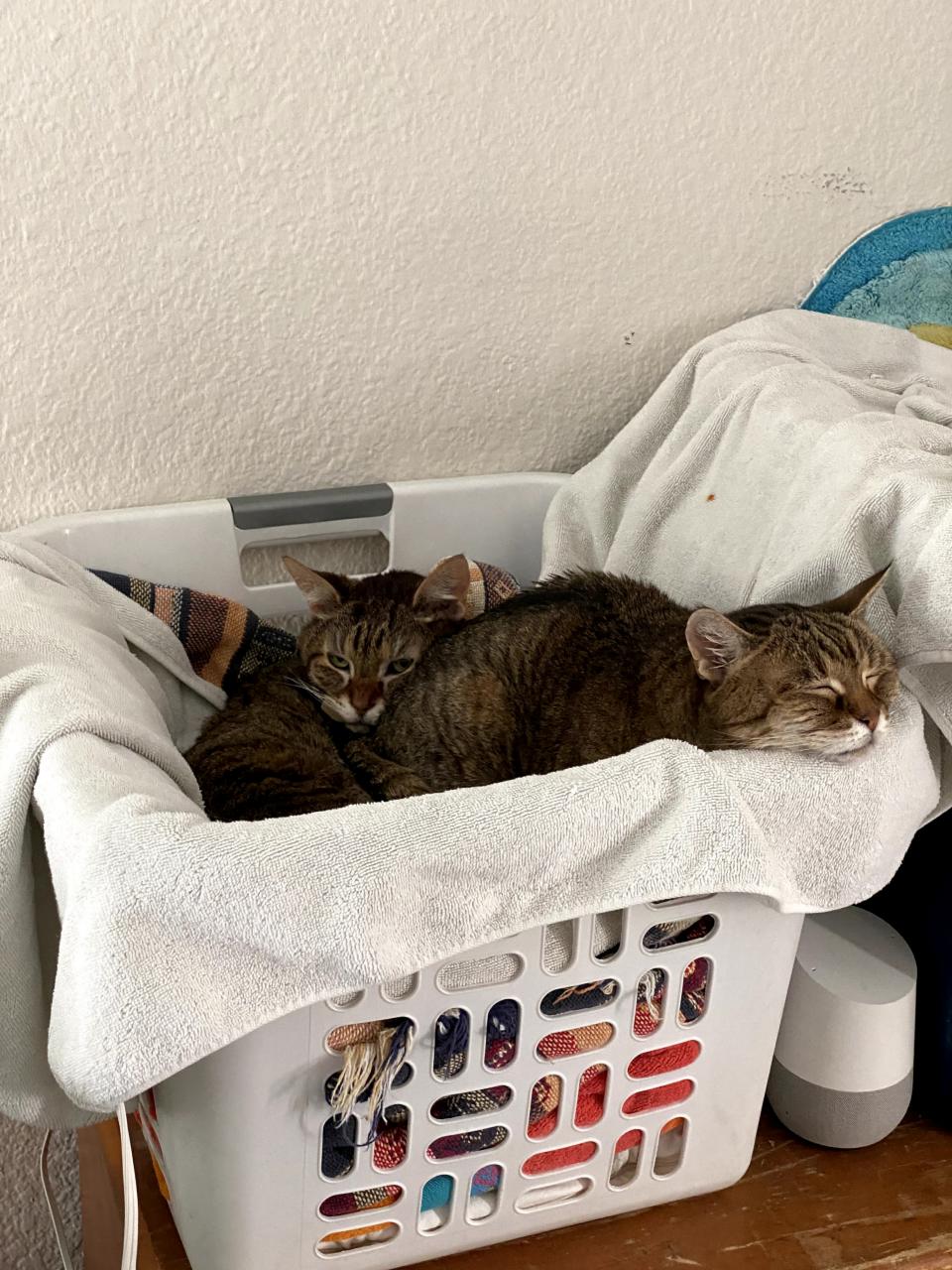
-
Hides - some manufactured cat hides have carpet, much like a scratching post, and some ‘hides’ are created on-the-fly by your cat on their own, but every cat appreciates a few cozy spots scattered around the house to find peace and quiet. We like the short, simple, round, carpeted round hide, since it fits well in so many spots and allows privacy for your kitty.
-
Pet stairs - often we think of these for small dogs, but cats will use them, too. Particularly as your pet ages, creating smaller ‘stair-like’ paths (with stable platforms, books, etc.) for them will help prevent injurious tumbles and falls.
Cat Leashes & Collars
-
Lupine - yup! They make amazing break-away cat collars, too. We love the reflective line for better visibility if your cat or kitten gets outside/lost. There’s a false narrative about cats being collared, but the humane society summed it up well: (they) euthanize thousands of cats annually because they don’t have a way to find an owner, but they have yet to find a cat who passed away from being (stuck) by its collar. Break-away collars are a safe and effective way to get your cat home safely.
-
Harnesses - there are two popular harness designs for cats - the “H” and the “figure 8”. Depending on the cat, you’ll find one fits more naturally than the other. Most cats ‘forget how to walk’ when you first harness them, so don’t worry! That’s normal. Just make sure they have good range-of-motion, and nothing is too snug or too loose. Never walk your cat in a new environment until they are comfortable with the harness, and this takes time! Some cats will adjust in days, others months - be patient. Harness ‘pro’s’ may come to appreciate the comfort and style of padded harnesses, but for first-time kitties, we feel less bulk is easier.
Grooming Cats
All tools will vary in usefulness depending on your pet’s coat, length, and sensitivity to touch. Introduce all new tools slowly, calmly, and with lots of praise and treats for calm/curious reactions. Never leave grooming tools unattended with your pet.
-
Quality small animal nail clippers I prefer the ones that open and close like scissors, but try several types to see what’s most comfortable in your hand. The better you are with them, the faster you’ll trim, and the less your pet will notice.
-
Styptic powder - while this can also go in the “first aid” section, whenever you’re cutting nails (or fur), you should have styptic powder nearby. Cornstarch or flour can do in a pinch, but actual styptic powder is much easier to use.
-
Quality slicker brushes - a good slicker brush has quality bristles that don’t bend or break and a base that doesn’t rust. It should feel even and smooth when you run it along your arm, and not poke-y or too scratchy. These are great for gentle brushing and for collecting extra fluff off cats, but may be too intense for young kittens or sensitive individuals. Go slowly with introductions and try to quit before your cat is annoyed to make grooming less stressful.
-
Baby wipes - the mildest, unscented ones you can find. I use them for ‘oopsies’ that stick in fur. Keep them by the cat bed or litter box to keep everyone safe from unexpected poopsiedaisies.
-
Pet shampoo - I do prefer to purchase a cat-specific shampoo from a reputable company because cats lick themselves so often that any residues can have a big impact on their health and wellbeing. I try not to wash cat faces with soap and water (wipes are easier), but if it must be done, I will still use (human) scent free, tear-free baby shampoo or diluted chlorhexidine.
-
Detangler it’s great to have a detangler spray if you have a medium- to long-coated breed. Cats tend not to love being sprayed, but if you spray the brush instead, it can still make a big difference in coat management. Be sure to purchase a “cat specific” product, and check ingredients, since most cats will self groom and ingest at least some of the residues.
-
Grooming gloves - I like grooming gloves for short-coated pets during our weekly grooming ritual. You can use them in the bath, too, but I prefer to feel my pet’s skin to make sure there are no areas of concern.
-
Electric clippers - an important tool for grooming many coat types, clippers can also remove fur around cuts and insect bites to help ensure your pet is healing properly. If a cat isn’t desensitized to these early and often, using them can be very scary/stressful. If your cat doesn’t respond well to the sound, a quality pair of stainless steel scissors will usually get the job done, too.
-
Chlorhexidine - a spectacular antiseptic that can be useful in so many ways. It’s our go-to for reptile and amphibian habitat disinfection, tear-free skin abrasion cleanser, and diluted it works great as an all-over wipe down for pets with severe seasonal allergies (remember, though, always see your veterinarian about sudden changes or persistent problems).
Miscellaneous Cat Accessories
It’s Potty Time
-
Litter Boxes these also come in many shapes, sizes, colors, styles, entry ways, etc., etc.. Cleanliness is our first priority, so if it’s too big/heavy to move, or too strangely shaped to scoop regularly, it’s a problem. If you have a young, healthy cat, we really like the ‘jump in’ style of litter box as this tends to result in fewer accidents and less litter spilled/tracked out of the box. For older kitties, access is everything, and a low-step-in and/or a larger area (think under-the-bed plastic storage tub) will help them succeed.
-
Litter - a lot of this will end up being your cat’s choice, but our favorites so far are Pretty Litter and World’s Best Cat Litter.
-
Litter mats - there are lots of types of litter, and just as many mats to try to keep that litter out of our beds! We like the Drymate litter mat because it stays in place on hard floors, doesn’t typically get tangled up in roomba, and stands up well to machine washing. The Clean Paws mat is much more plush, still machine washable, and very comfortable to walk on barefoot for us humans.
-
Pee pads - these can be useful for lining litter box areas, or even popular cat nest sites to keep things clean and sanitary. We love the washable PoochPad, but if we’re lining a cat bed during behavior training, we turn to Frisco’s unscented (meaning no ‘attractant’) or (if you can find them) Pl360 at Target had an unscented product that was great, too.
-
Natures Miracle - there’s no product we’ve encountered that parallels Nature’s Miracle for removing pet stains and accidents.
Meal time
-
Bowls - bowls can be fun, personalized, and functional, but our main emphasis is that they should be clean. Cats and kittens are often messy eaters, so be sure you have enough bowls (or enough time) to put down a fresh bowl for every meal. While there is some correlation between cat acne and plastic bowls, we’ve found a well-cleaned bowl matters more than the material for all our fosters, rescues, and boarders thus far. Due to this, we don’t recommend the ‘self-filling’ bowls for cats, since they are usually both plastic and cleaned less frequently (double trouble).
-
Feeding station mats - Cats and kittens are often messy eaters, so why not be one step ahead? An old towel, an old tv-tray with a lip, a plastic serving tray with a lip - anything that can help contain the mess and is easy to wipe clean is going to help. They also sell silicone mats specifically designed for feeding stations, which are dishwasher safe, too.
-
SureFeed - this is the only feeder we’ve ever encountered that limits entry to only a specific set of pets. You can ‘teach’ the SureFeed to recognize certain pets (by either their microchip or by a tag you put on their collar). Then, only those ‘recognized’ pets will be able to trigger the feeder to ‘open’ - perfect for cats who want to ‘graze’ throughout the day, but cohabitate with dogs/cats who prefer to eat everything in one bite. Life-changing for the owners of pets with different dietary restrictions. The volume of dry or wet food it holds is too little for us to recommend it for most dogs, but it is spectacular for cats of all ages. (One draw back? It’s fussy about getting wet. Store away from water bowls or any place it could get soaked; when cleaning, spray a paper towel with your cleaning agent of choice and wipe down, don’t directly spray the device.)
-
Cat fountains - lots of models to choose from here, too! We prefer one that has an active carbon component in the filtration. That said, it’s still important to thoroughly clean, sanitize, and completely change fountains regularly. We’ve been happy with the CatIt Flower fountain, and we really appreciate the different options that come standard to allow customization for your cats’ preferences in how ‘splashy’ the water fountain behaves.
Travel
Always have identification on your cat and on their carrier when traveling. It is wise to include an emergency contact outside your immediate household, if possible, in case of natural disasters or accidents. Digital or physical copies of your pet’s vaccination and medical records are also handy. If you’re traveling far from home, it is also important to bring a supply of any necessary medications in a travel or ‘go’ bag that can attach to your pet’s carrier, safely out of their grasp. Be sure to keep microchip information current, too.
- Pet carriers - While a solidly constructed plastic carrier with a locking door is a ‘must’ in our book, many cats do prefer to travel in a soft-sided mesh bag. The best option for you and your cat will depend on the local weather, the type of travel, and the duration your pet will stay in the crate. In an ideal world, you could leave the crate out all the time, and give your cat or kitten treats and snacks in the crate to encourage a positive association. If your pet already feels strongly (negatively) about the crate, this process may take longer, but persistence and patience usually overcome any objections.
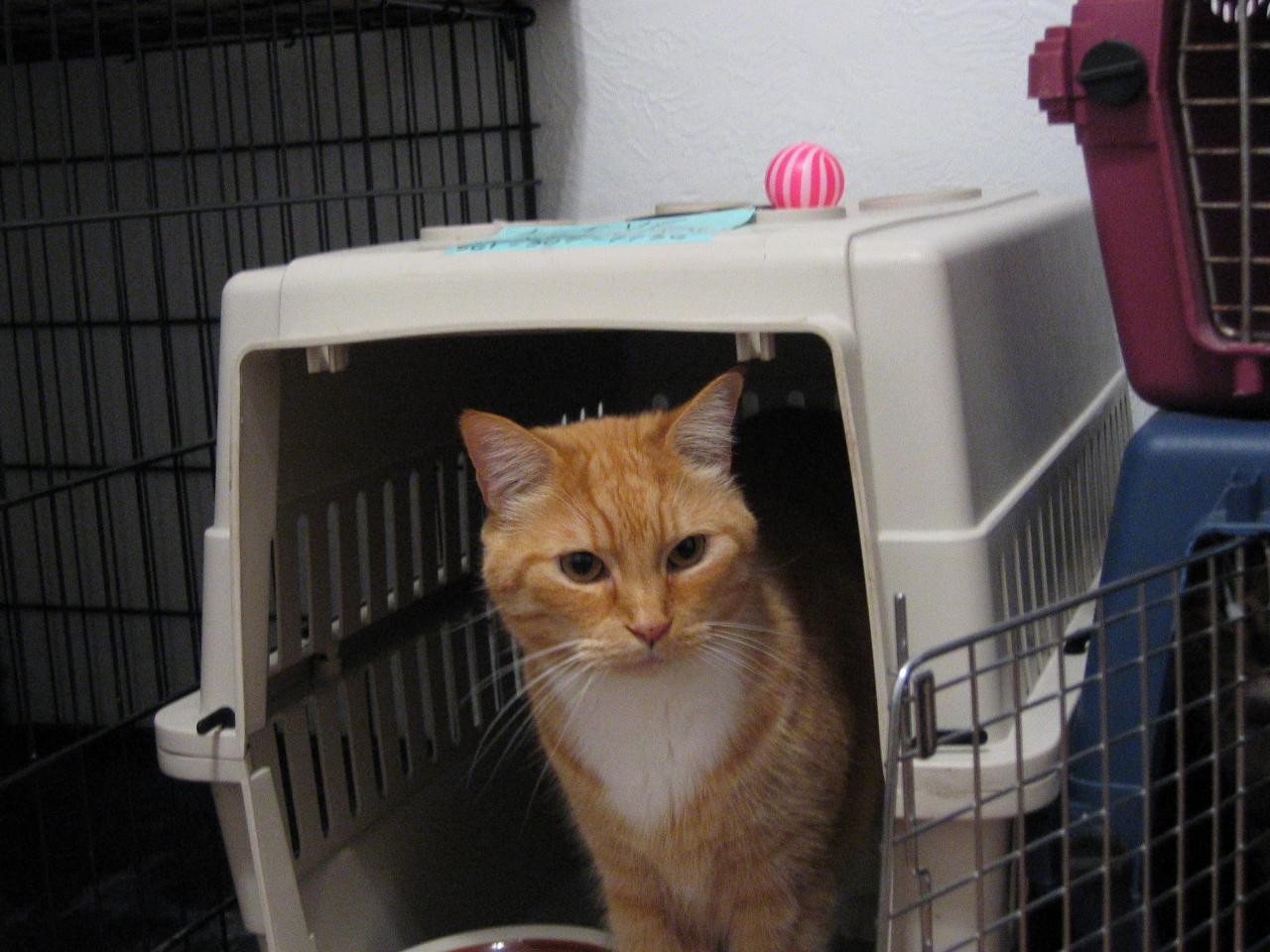
-
Thunderease Cat Pheromone Spray - the diffusers are great for helping kitties adjust more quickly to a new territory (moving), but the spray is a bit more practical for travel.
-
Lupine - yup! They make amazing break-away cat collars, too. We love the reflective line for better visibility if your cat or kitten gets outside/lost. Always have identification on your cat and their carrier when traveling.
First Aid
Always discuss medications and treatments with a licensed veterinarian. If possible, take an emergency pet first aid course locally. The following is just a list of ‘useful’ things we try to keep in our home for pet and human emergencies. Your ideal list will look different depending on your location, proximity to emergency veterinary care, and frequent activities (hiking, camping, strolling down city sidewalks, marathons, etc).
On the Go
- Styptic powder (aka KwikStop) - as mentioned in Grooming, styptic powder is great to have for minor cuts and whenever nail trimming. It’s light weight and very temperature stable, so we try to keep some in hiking packs and vehicles, too.
- Gauze
- Chlorhexidine
- Salve and/or hydrocortisone cream for bug bites
- Vet Wrap
- Cerenia or other anti-nausea medication for car sickness
- Benadryl or other pet-safe antihistamine for allergic reactions (e.g. bee stings)
- tick tweezers (forceps) or other precise removal tool
- sterile saline solution
- magnifying tool for splinters or to inspect skin irritations
- Super absorbent travel towels
- reflective blanket
- heat pack
- instant ice pack
- clean water
- betadine (5% providone-iodine)
- rubbing alcohol (mostly to sterilize tools - it burns in wounds, so I try to avoid it)
- small, stainless steel surgical scissors
- safety pins of various sizes
- triple antibiotic cream
- plastic baggies - they’re versatile and amazing
- Cotton swabs
- Cotton balls
- lighter (for sterilizing tools; be sure to cool tools before touching them to your pet or yourself)
Plus, at home
- electric clippers to shave area around minor wounds or insect bites
- ipecac or 3% hydrogen peroxide
- clean, dry towels
- ‘cone of shame’ or supplies to improvise a cone
- Nature’s Miracle advanced platinum stain remover (to disinfect and remove blood and excrement)
- Thermometer (labeled for pets… otherwise… crossover equipment is not optimal for the humans)
- unflavored, clear Pedialyte
- Pumpkin puree
- Plain white rice
Reptile Goodies
Housing & more
The most important part of reptile housing is meeting the individual animal’s needs, and depending on your home environment different enclosures will be better or worse at keeping conditions stable.
- A quality thermostat to keep temperatures stable and all for proper thermoregulation.
- Coco peat
- Vision cages
- Beeger Boxes
- Rhino Raxx
- Stoneware or ceramic, smooth-coated, solid water/food bowls Pick bowls without hollow spaces where critters could get stuck. Those ‘realistic’ bowls look neat in the store, but the rough surfaces provide lots of hard-to-clean surface area for fecal debris and microbial growth, which can get your pet sick. Be sure to choose dishes that are the appropriate depth for your pet, or provide smooth stones to assist with entry/exit from the bowl (particularly important for tortoises!).
- Infrared thermometer to check temperatures. We prefer the small ones to the ‘guns’ for reaching smaller spaces in an enclosure (ie if your snake always curls up under a rock pile, you need to temp-check that precises space). Shy reptiles will pick cozy spots that feel safe over temperature-appropriate spaces, and that can negatively impact digestion and appetite. Be sure the ‘safe’ spaces in the enclosure are also ‘digestion temperature’ to help encourage healthy eating habits.
’* We are now ambassadors for NoxGear; we continue to love their products after 4 years of heavy use’
- We are working with Calmr Dog to further research to help dogs find calm & balance